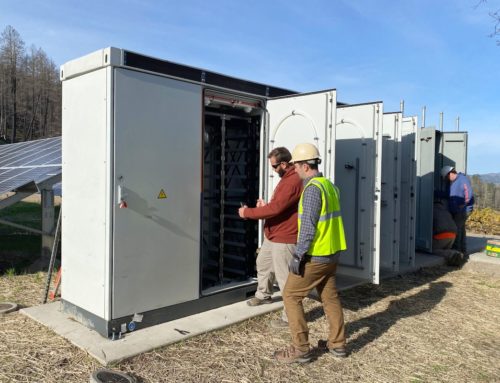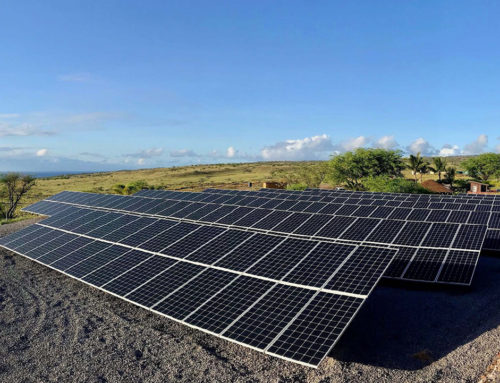Scattered across the world’s oceans there are thousands of islands each with their own unique ecosystems, vibrant culture, and beautiful coastlines. Harbledown Island, found off the coast of Canada’s British Columbia, shares many of these qualities. However, Harbledown and many islands like it share another less pristine commonality: the burning of fossil fuels as the only means to provide electricity to their community, the high cost of energy, the harmful emissions, and the constant hum of a diesel generator as an unwelcome background to the natural sounds of the island.
Harbledown has relied on diesel power since electricity was introduced to the island many years ago. That is until a renewable energy microgrid was commissioned in 2020 by Hakai Energy Solutions in partnership with Ageto. For the first time in decades, the residents of the island enjoyed the sounds of nature again when the generators turned off and the solar and storage took over.
Islands like Harbledown make a great case for renewable energy microgrids for a number of reasons. Like many islands or extremely remote communities, Harbledown is home to a small First Nations community. These communities are far beyond the edge of the electric grid that serves so many of us. As a result, they often pay a high price for electricity, historically generated by burning diesel shipped in by barge or flown in by plane. With the installation of a renewable energy microgrid, the diesel generators can act as a backup for the solar and storage and can turn off as conditions allow. A well-designed, sized, and controlled renewable energy microgrid such as the one on Harbledown Island can operate for days at a time without once needing to start the generators.
Many lessons can be learned from the commissioning of a remote renewable energy microgrid such as this one. These unique challenges and solutions will be shared here, including the hurdles placed by the significant interruption posed by the COVID-19 pandemic. Ageto has collected almost a year of data from this site and is excited to share what it shows for this site, what it means for future island microgrids and how an intelligent renewable energy microgrid controller optimizes the system and provides an extra layer of resilience.
A new power system solution
Previous to the installation of this renewable energy microgrid, Harbledown relied on 3 diesel generators to deliver power to the entire community. Although diesel generators are a solution that are able to provide consistent power to an island community there are several problems they present. If electricity is not subsidized, one of the biggest problems is the high cost of electricity for community members as a result of the large expense of transporting the diesel to the island. Not only is the transportation expensive, but it also means fossil fuel is burned to provide electricity for the island before any fuel even meets the generator. The generators are a reliable way to provide electricity to the island but are loud, expensive, and polluting.
That’s when a renewable energy microgrid comes in. The Harbledown renewable energy microgrid project, like many microgrid projects, took time and work before it was commissioned. The first conversations began in 2018 and the island microgrid was finally commissioned in two phases in 2020. In June of 2020, the first phase was commissioned including 120 kW of SMA CORE1 solar and ComAp controllers on the diesel generators. In August of 2020, the second phase was installed adding a Dynapower MPS-i125 energy storage system with 440 kWh of Samsung E3 batteries. As with all projects, the last part to be installed and commissioned was the Ageto ARC renewable energy microgrid controller. The Harbledown Island renewable energy microgrid controller is designed to automatically operate the system in a reliable, resilient, and autonomous manner, seamlessly supplying the system load via a mix of solar power, battery storage, and generator. When conditions allow, the generators turn off and the system runs on solar and battery storage alone. On many exciting occasions, the island microgrid has run for multiple days on 100% renewable energy. Microgrids are able to bring safe, reliable, inexpensive, and clean energy to communities such as Harbledown and others like it.
Remote Commissioning
Designing an island microgrid is complex, however, bringing that design into fruition can be even more complicated. The Harbledown renewable energy microgrid project was ready to be commissioned in the spring of 2020 after the installation of three new generators . Coincidentally, that is when COVID-19 stopped all international travel. Ageto, with the onsite expertise of the Hakai engineers, was able to innovate a solution to commission the project remotely and get this project up and running without further delay. Typically, an Ageto engineer travels to site to configure the assets and troubleshoot any issues. Through the remote gateway included in ARC, in this instance a satellite connection to the island, Ageto is able to remote into any microgrid system, typically for visibility, remote monitoring, and control. It was this connection that allowed Ageto to remote into the system to perform an atypical commissioning with the Hakai engineers as the eyes and ears onsite. This teamwork, creativity, and innovation kept the project from being delayed any further and provided the people of Harbledown with the renewable energy microgrid that was promised.
Resilience
A major importance of a renewable energy microgrid, especially an island microgrid, is power reliability. If the microgrid goes black, there is no grid to fall back on. That is why it is so important for a renewable energy microgrid controller to be reliable, robust and constantly communicating with the devices in the system to provide visibility into the performance and health of all of the assets within the system. The Ageto ARC microgrid controller communicates at one-second intervals and follows algorithms tailored to each site to determine how to optimize and control the system. ARC monitors the state of charge (SOC) of the battery, solar production, total load, and hundreds of other energy parameters which it synthesizes to make decisions on when to discharge the batteries or turn the generators on, providing a constant supply of power. The Harbledown microgrid is a mix of traditional and renewable distributed energy resources (DER). Microgrids such as this are able to provide a high level of reliability, but also bring high levels of complexity. The Ageto ARC microgrid controller brings another layer of reliability by running both the energy storage and the generator in grid forming mode, the inverter utilizing droop control setpoints and the generators run in isoch. If there is a fault in either resource the other is able to seamlessly take over forming the voltage and frequency for the grid without a blackout. Resilience is a high priority for Ageto. That is why we innovated to develop a “resiliency mode”. With one click, a system operator is able to inform their system to prepare for severe weather or other extreme conditions by increasing the spinning reserves on the system.
Lessons Learned
Developing a successful renewable energy microgrid system is complex and challenging. There are many energy resources, project goals, constraints, and stakeholders that all need to be well understood and coordinated. Bringing these moving parts together takes time, expertise, and flexibility. The original commissioning was planned for July of 2019, but due to many reasons, this was pushed back by almost a year.
It is important that those delivering a renewable energy microgrid controller understand all aspects of a system so that the final project that is delivered performs as expected and meets the goals set forward by the project stakeholders. Ageto prioritizes responsiveness and expertise. Helping all partners involved understand their role in the system expedites the process as well as finding and solving potential problems. Ageto’s ARC controller is configurable to meet the narrative that the customer wants and has the expertise to know it will work.
Bringing a renewable energy microgrid project to fruition is a complex process, but when done well can serve as a great example of a successful alternative power system.
Current Performance
The Harbledown renewable energy microgrid has been operating autonomously for almost a year without fault and has been able to operate generators off for multiple consecutive days on many occasions. As of April 2021, 8 months since the storage was installed, the system has saved the community $15,000 in diesel fuel, thousands in generator maintenance costs, and has offset over 35 tons of CO2 emissions. In one week in April, the system achieved 85% renewable energy penetration.
Harbledown serves as a great example of the many benefits a renewable energy microgrid system can bring to a remote community. Ageto is working to accelerate the adoption of renewable energy microgrids for these island communities across the world.



